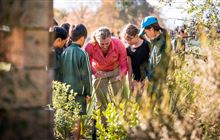Mapping near, there and far
Introduction
Explore outside with your senses and map your nature.View and download the activity in English or Te Reo Māori.
Mapping near, there and far
Ko Ranginui e tū iho nei, Ko Papatuānuku e takoto nei. Ko ngā hau ora o Tāwhirimātea e pupuhi nei. Haumie Hui e … Taiki e.
Ranginui stands above, Papatuānuku lays below. The winds of Tawhirimātea blows around us. It is done, it is complete.
When taking time to look around us, we acknowledge the sky father, the earth mother. We take time to acknowledge the breeze and winds of Tāwhirimātea.
Mapping near, there and far activity card (PDF, 1,078K)
Activity – Get active and map outside
Draw a spot in the middle of a page. This represents where you are.
Draw three concentric circles around the dot and mark them with near, there and far.
Choose a sense to focus on – hearing, smelling, seeing, or all three.
Head outside and find a comfy place to sit or stand quietly.
Practice a body scan to help tamariki centre themselves to the land.
Focusing on their chosen sense/s, ask tamariki to notice what is ‘near’.
Repeat for ‘there’ and ‘far’.
Record what you see/hear/smell in words or drawings in the first circle.
Count the steps to your ‘there’ spot and run back again.
Curriculum Links
English
- Make lists of the nature you can see, touch, hear and smell.
- If you were to give an animal or plant you saw a name, what would it be, and why?
- Create similes and metaphors to describe your outdoor space (eg a flower as yellow as the sun).
- Create a sensory poem to describe your outdoor space.
- Create a listening poem about what you hear in your outdoor space.
- Write a poem or story about an animal or plant you saw. What do you admire about it?
Mathematics and statistics – geometry and measurement
- Measure/estimate the distance to your ‘there’ and ‘far’ places. What unit of measure is best to use?
- Draw a map of your ‘near’, ‘there’ and ‘far’ environment and show the position of your listed items.
- Create a sound map as a class.
- Use a coordinate system.
- Write directions to the location of your ‘far’ place from your classroom. Test your directions with a buddy.
- Carry out a statistical investigation with your classmates.
- How many people noticed the same things?
- What senses were used most? What senses would your classmates like to use more?
- What sounds were the most familiar? What sound did you like best? Why?
Health and physical education
- Get active with a game like go home, stay home, in your mapping area.
- Map your wellbeing
- How many skips, jumps or hops to your ‘there’ space?
- Run to your ‘far’ place in the school grounds. How long does it take to run there are back?
The arts
- What sounds did you hear outside? Use instruments and/or natural objects to recreate the sounds you heard.
- Compose your own musical piece and/or write a waiata/song to describe your outdoor space.
- Perform your song for your class, whānau or friends.
Konei, konā, kora
Ko Ranginui e tū iho nei, Ko Papatuānuku e takoto nei. Ko ngā hau ora o Tāwhirimātea e pupuhi nei. Haumie Hui e … Taiki e.
Toro atu ki waho, mā ōu pūkenga rongo e mahere ai koe i tāu taiao. I a mātau e mātirotiro ana, whai wā ki a Ranginui, whai wā anō hoki ki a Papatuānuku.
Whai wā ki ngā hau kāwatawata a Tāwhirimātea.
Konei, konā, kora (PDF, 1,071K)
Korikori ka mahere o waho
Tāngia he ira ki wainganui i tētahi whārangi. Ko koe tēnā e noho nei.
Tāngia kia toru ngā porohita pūrite e huriana i taua ira. Kātahi ka whakaīngoatia aua porohita, konei, konā, korā.
Aro ki tētahi o āu tairongo. Te rongo-ā-taringa (whakarongo), te rongo-ā-ihu (kakara), me te rongo-ā-kite (titiro).
Puta atu ki waho ka tirohia he wāhi pai hei noho, hei tū rānei.
Whakangungutia he whakataunga wairua, kia tau ai te mauri o ngā tamariki ki te whenua.
Aro ki te tūmomo rongo i whiria e rātau, kātahi ka tomo atu kia aro ki ngā mea i ‘konei’.
Tuhia/tāngia ngā mea ka kitea/rangona/rongo kakara ki te porohita tuatahi.
Inaianei whaia te huarahi anō – heoi ki te porohita tuarua ‘konā’ kātahi ki te porohita o ‘korā’.
Kaute i āu tapuwae e tae ai ki ‘konā’ ka oma atu ki te tīmatanga.
Ka tūhono ki Te Marautanga
Reo
- Tuhia he kupu taka o ngā mea o te taiao i kitea, i rangona, i pā.
- Inā whakaīngoatia koe i tētahi mea i kitea e koe, he aha taua īngoa? He aha ai?
- Titongia he kupu whakarite hei whakamārama i te wāhi o waho. (Te kowhai o te putiputi anō nei he rā).
- Titongia he rotarota tairongo hei whakamārama i te wāhi o waho.
- Titongia he rotarota mō tāu i rongo ai i waho.
- Titongia he rotarota, he pūrākau mō ngā tūmomo kararehe, ngā rākau i kitea e koe. I manahau ai te aha?
Pangarau
- Whakatau tata i te tawhiti mai tāu wāhi ‘konā’ ki tāu wāhi ‘korā’. He aha te waeine e pai ai te ine i taua tawhiti?
- Tāngia he mahere o āu wāhi ‘konei’, ‘konā’, ‘korā’ e whakaatu ana i ngā wāhanga o ngā kupu o tāu kupu taka.
- Hangaia he mahere oro ā-akomanga.
- Whakamahia he pūnaha whakarite.
- Tuhia i ētahi tohutohu mai tōu akomanga tae noa ki tāu wāhi ‘korā’. Mā tētahi hoa e whakamātau.
- Mahia he tatauranga me ōu hoa ako.
- Ēhea ngā tamariki i kitea ngā mea ōrite i a koe?
- He aha ngā momo rongo i kaha whakamahia? He aha ngā rongo e pirangi ana ngā ākonga ki te whakamahi anō?
- He aha te momo oro waia ana? He aha te momo oro pai ki a koe?
Hauora
- Korikori haere me tētahi kēmu.
- Ēhea ngā hītoki, mawhiti, peke rānei e tae ai koe ki tāu wāhi ‘konā’?
- Oma atu ki tāu wāhi ‘korā’ kei roto tonu i ngā taiapa o te kura. Ēhea te roa e tae atu koe ki reirā, kātahi.
Ngā Toi
- He aha tāu i rongo ai i waho? Whakamahia he pūoro, he taputapu o te taiao rānei e puta ai ngā oro o tāu i rongo ai.
- Titongia he waiata ā-puoro, ā-reowaiata rānei hei whakamārama i te taiao.
- Whakangahau ki tāu akomanga, ki tāu whanau, ki ōu hoa hoki.



